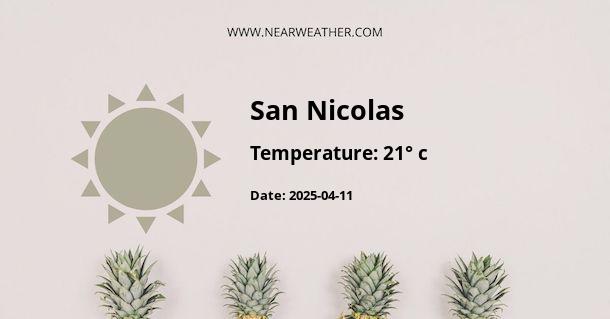San Nicolas, Argentina: A Comprehensive Guide to Climate and Weather Year Round
San Nicolas, located in the Buenos Aires province of Argentina, is known for its rich cultural heritage, picturesque landscapes, and diverse climate. Understanding the weather patterns and climate variations in San Nicolas is vital for residents, tourists, and businesses alike. This comprehensive guide provides an in-depth analysis of the climate and weather conditions in San Nicolas throughout the year.
Climate Overview
San Nicolas experiences a humid subtropical climate, characterized by hot, humid summers and mild winters. The city's proximity to the Paraná River contributes to its unique climate patterns. The region's climate is also influenced by its geographical location, with occasional cold fronts originating from the south.
Temperature and Precipitation
The table below illustrates the average monthly temperatures and precipitation levels in San Nicolas:
| Month | Average High (°C) | Average Low (°C) | Precipitation (mm) |
|---|---|---|---|
| January | 31 | 19 | 115 |
| February | 29 | 18 | 105 |
| March | 28 | 17 | 130 |
| April | 24 | 14 | 80 |
| May | 20 | 10 | 60 |
| June | 17 | 7 | 40 |
| July | 16 | 7 | 30 |
| August | 18 | 8 | 40 |
| September | 20 | 10 | 65 |
| October | 24 | 13 | 95 |
| November | 27 | 16 | 110 |
| December | 30 | 18 | 115 |
As depicted in the table, the summer months of January and February experience high temperatures with substantial precipitation, while the winter months of June and July have cool temperatures with minimal rainfall. Understanding these temperature and precipitation patterns is crucial for various outdoor activities, agricultural planning, and infrastructure development in San Nicolas.
Extreme Weather Events
San Nicolas is susceptible to occasional extreme weather events, including thunderstorms, heavy rainfall, and heatwaves during the summer months. These events can impact local infrastructure, agriculture, and public safety. It is essential for residents and businesses to stay informed about weather forecasts and emergency preparedness measures to mitigate the impact of extreme weather events.
Annual Climate Variation
The chart below illustrates the annual climate variation in San Nicolas, showcasing the average monthly temperatures and precipitation levels throughout the year.

Seasonal Impact on Tourism and Agriculture
The distinct seasonal variations in San Nicolas have a significant impact on tourism and agricultural activities. The region's warm summers attract tourists to enjoy outdoor recreational activities, while the moderate winters provide favorable conditions for agricultural activities such as citrus and soybean cultivation. Understanding the seasonal impact is vital for businesses and policymakers to develop targeted strategies for tourism promotion and agricultural productivity.
Conclusion
In conclusion, San Nicolas, Argentina, boasts a diverse climate with distinct seasonal variations. The region experiences hot, humid summers and mild winters, with varying levels of precipitation throughout the year. Understanding the climate and weather patterns in San Nicolas is essential for residents, businesses, and policymakers to make informed decisions regarding outdoor activities, agricultural planning, and infrastructure development. By considering the comprehensive insights provided in this guide, individuals and entities can navigate the climate variations and leverage the unique attributes of San Nicolas for sustainable growth and development.
A - San Nicolas's Latitude is -34.605019 & Longitude is -58.376068.
A - Weather in San Nicolas is 21° today.
A - Climate Conditions in San Nicolas shows light intensity drizzle today.
A - Humidity in San Nicolas is 88% today.
A - Wind speed in San Nicolas is 27.79 km/h, flowing at 120° wind direction. today.
